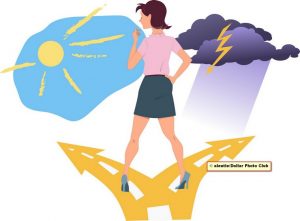Holistic Approach to Bipolar Illness – Part 1
BPI (Bipolar illness),
often referred to as bipolar disorder or manic depression, affects more than 2.2 million people in the United States. BPI is characterized by bouts of illness with significant often disabling symptoms, alternating with periods of less or no symptoms. These may be a sign of the disorder: unusual shifts in mood, energy or the ability to function.
What is happening to Sarah?*

Because of the insistence of her family and one of her ex-husbands, Sarah had been to several mental health evaluations. She had been married and divorced four times and in and out of many jobs. She had an early life history of trauma: at age 14, she was sexually abused by her divorced mother’s live-in boyfriend; at age 15, she was raped when at a party. She occasionally had nightmares about the incidences and had triggered flashbacks, or panic like attacks, when she smelled certain odors or sounds reminiscent of her rape. She had made several suicidal attempts during recurring periods of severe depression. Hospitalization was required two times when her doctors considered her to be a danger to herself. Her mother and one aunt had a history of bipolar illness. Sarah never had any severe period of mood activation or mania, though one of her treating psychiatrist thought she had periods of what he called hypomania (milder periods of mood, behavior activation or changes). Her diagnosis was Bipolar II type of BPI and PTSD (Post Traumatic Stress Disorder). Her best response to treatment finally came when she received appropriate treatments and therapy for both BPI and PTSD, and when she also sought out the help of a holistically oriented health care provider who encouraged her to follow a more optimal health, nutritional, spiritual lifestyle program.
*(To protect confidentiality, the above is a composite of some clinical experiences and does not represent an actual person or any prior patients).
Sarah’s family and significant others began to pay attention and to take action when her once normal ups and downs of everyday life began to get more dramatic, extreme and destructive. If you, a family member, or someone you know shows unusual shifts in mood and energy with uncharacteristic behaviors, it may be an early sign of bipolar illness (BPI).
Getting evaluation and treatment when needed.
Evaluation by a trained professional such as a psychologist or psychiatrist should be considered when changes in moods are severe, persistent, and interfering with daily life. Identify BPI early in its course and treat with a comprehensive, holistic treatment program. If not, the illness can have devastating effects on relationships, careers and health – as was the case of Sarah.
Recurrence of bipolar episodes with depression, anxiety, mania or hypomania has adverse effects on family, social and occupational functioning. BPI disrupts many normal day to day activities in areas as:
- social functioning and relationships
- work and productivity
- sleep and physical health
Recognize bipolar illness in all its forms.
The illness can lead to impaired thinking (cognition), poor judgments, increased distractibility (poor focus), dysphoria (painful moods) and physical discomfort with increased preoccupations with health problems. There can be compromised functioning as with:
- more impulsive or volatile behavior and expression
- loss of interest, pleasure and motivation in doing things
- suicidal thinking.
BPI’s early appearance is often not recognized by significant others or by health-care providers. A key feature that separates the illness from recurring depression is the occurrence of hypomania or a more severe manic episode. A manic episode is a period of elevated, expansive or irritable moods, and increase goal-directed activity or energy – often lasting for at least a week – which is a characteristic of the more severe bipolar I type of BPI.

Other commonly associated symptoms may include:
- inflated self-esteem or grandiosity
- decreased need to sleep
- more talkative than usual or pressure to keep talking
- flight of ideas or the experience of racing thoughts
- distractibility
- increase goal-directed activity
- excessive involvement in high risk activities
- marked impairment in social and work functioning
- sometimes need for hospitalization (if potential for harm to self or others and/or the presence of poor judgement and thought disturbance – psychotic symptoms)
In Bipolar I disorder, the manic episode may have been preceded or followed by hypomania or major depressive episodes. Milder “hypomanic” episodes can have:
- a persistent elevated, expansive or irritable mood
- signs of sharpened and overly active thinking (hyper-focused)
- increased energy and activity that last for at least four consecutive days (present for most of the day – nearly every day)
This “hypomania” alternates with frequent periods of depression and are typical of the less dramatic bipolar II type of the bipolar illness. Recurrent depression is characteristic of both conditions, and the depth of the depression usually determines overall severity.
Both bipolar I and bipolar II types of BPI can be both severe and disabling. Bipolar I disorder more specifically describes a sufferer who has experienced distinct periods of severe depression or hypomania, alternating with at least one episode of severe activation or mania. Bipolar II disorder, by definition, has not had any manic episode. If mania later presents in bipolar II individuals, this results in reclassification to Bipolar I type of BPI.
Symptoms of Bipolar II have a similarity to those seen in Bipolar I but are often milder, less severe, or more subtle as:
- inflated self-esteem or grandiosity
- decreased need for sleep
- more talkative than usual or pressure to keep talking
- flight of ideas or racing thoughts
- distractibility
- agitation
- increase in goal directed, hyper-focused activity (school, work, socially or sexually)
Some subtler bipolar I or bipolar II conditions, at any given time, can present with milder and more difficult to recognize symptoms as irritability, anxiety, and moodiness – alternating with periods of less pronounced depression. Another classification, for the entire range of BPI in its varying expression, is — bipolar spectrum illness — which would include even the less recognizable forms of recurrent depression with milder periods of activation, hypomania and less dramatic symptoms.
For clear description and definition of BPI, go to the current American Psychiatric Association — the official nomenclature that has been codified and defined in the DSM-5 (published by American Psychiatric Publishing).
What is the cause of bipolar illness and who is affected?
Bipolar illness is considered an inherited condition related to instability in brain neurotransmitters (nerve chemicals) regulation, which leads to greater vulnerability to emotional or physical stress, over-stimulation, upsetting life experiences, drug or alcohol use, and interference with rest and sleep. The brain is not able to properly calm or activate itself, or restore its usual healthy balance.
Research studies strongly support inherited genetic factors as important contributors to BPI. First-degree relatives of people with BPI are seven times more likely to develop bipolar I type of BPI. Environmental factors (epigenetic factors) are also suspected to affect bipolar illness — physical factors (as radiation or trauma), chemical factors (as pesticides, toxic metals, and air pollution) and biologic influences (as bacteria, mold, viruses).
Lifetime prevalence estimates are 1% for bipolar I disorder — BP 1 type of BPI, 1.1% for bipolar II disorder (BP 2 type of BPI), and 2.4% to 4.7% for sub-threshold BPI (a person is not meeting the full symptom criteria for BP 1 or BP 2). Age of onset range from childhood to the mid-20s and later, and BPI onset is unusual after age 40. Recurrence of active BPI over a five year period is very common – with the associate in between times of no symptoms, minor symptoms, or with significant residual symptoms. (see “Bipolar Disorder” by Vinitsky and Parks, Advancing Medicine with Food and Nutrients, 2nd edition, Chapter 32, Dec. 2012, CRC Press)
When can depression actually be bipolar illness?
Recurrent depression is often bipolar illness unrecognized. Additional clues to underlying BPI include:
- poor response to treatment for depression
- manic or psychotic symptoms
- rapid mood fluctuations triggered by antidepressants
- family history of bipolar illness
- onset or recurrent depression before the 20s
- severe premenstrual syndrome, PMS, or premenstrual dysphoria syndrome (PMDS)
- postpartum depression
- atypical depression with a lot of irritability, sleep disturbance and anxiety.
At its worst, BPI can lead to higher mortality from suicide and other co-occurring medical illnesses. Among psychiatric disorders, BPI has a significant risk of death from suicide. The risk in bipolar 2 type of BPI for suicide is greater than bipolar 1 type of BPI – according to some studies. Unrecognized co-occurrence of BPI, with other mental or physical illness, can lead to ineffectual treatment and poor outcomes. Six months after suffering a myocardial infarction, victims with major depression – commonly seen in BPI – had six times the mortality rate of non-depressed patients. Presentation of BPI in the older population, greater than 50 years, will often have other medical problems at the time of diagnoses – including cognitive changes. More than 50 percent of people will abuse drugs or alcohol if BPI is not recognized and treated.
Bipolar illness can be overlooked or misdiagnosed resulting in inadequate treatment.
People with this disorder are sometimes misdiagnosed as having just depression, and treated as such, often resulting in a poor treatment outcome. These individuals would respond better to a bipolar illness focused treatment program. (see for more information)
A holistic or integrative approach to the study and treatment of BPI offers a better path to disease understanding, treatment and prevention of future illness.

With a broader open health-care model, there is the potential for improved research, diagnosis and treatment of BPI. All disciplines can be included in an integrative model – including biochemistry; psycho-pharmacology; toxicology; genetics; spirituality; psychology; physiology; endocrinology; sociology; and nutritional, metabolic, environmental, psychiatric medicine and complementary mind/body/spiritual therapies. Effective outcomes can happen with patience and commitment to finding a suitable care and treatment program as occurred with Sarah – as described above.
(For support and assistance consider below sites):
Part 2 of this topic: “Holistic Treatment of Bipolar Illness.”
Article by Ron Parks, MD and edited by Shan Parks
Question:
What would be your first consideration, if you or a significant other is developing signs of bipolar illness? I would like to hear your comments.
